
95% of researchers rate our articles as excellent or good
Learn more about the work of our research integrity team to safeguard the quality of each article we publish.
Find out more
ORIGINAL RESEARCH article
Front. Microbiol. , 13 March 2019
Sec. Aquatic Microbiology
Volume 10 - 2019 | https://doi.org/10.3389/fmicb.2019.00451
This article is part of the Research Topic Microbial Ecology in Reservoirs and Lakes View all 22 articles
Large-scale harmful algal blooms (HABs) occur in the coastal waters of the northern Beibu Gulf, China, and have deleterious effects on the marine ecosystem. The frequency, duration, and extent of HAB events in this region have increased over the last 30 years. However, the underlying causes of HABs and their likely future trends are unclear. To investigate, we evaluated historical data for temporal trends of HABs in the Beibu Gulf, and association with environmental factors as possible drivers. The results confirmed that HAB events had increased in frequency, from 6 reported events during the period 1985–2000, to 13 during 2001–2010, and 20 during 2011–2017. We also found that the geographic scale of algal blooms had increased from tens of km2 to hundreds of km2. There were temporal changes in HAB trigger species: prior to 2000, the cyanobacteria Microcystis aeruginosa was the dominant species, while during the period 2001–2010, blooms of cyanobacteria, dinoflagellates, and diatoms co-occurred, and during 2011–2017, the haptophyte Phaeocystis globosa became the dominant algal bloom species. Principal component analysis and variation partitioning analysis indicated that nutrient discharge, industrial development, and human activities were the key drivers of HAB events, and redundancy analysis showed that variation in the algal community tended to be driven by nutrient structure. Other factors, such as shipping activities and mariculture, also contributed to HAB events and algal succession, especially to P. globosa blooms. We speculated that the increasing severity of algal blooms in the northern Beibu Gulf reflects a more complex aquatic environment and highlights the damaging effects of anthropogenic inputs, urbanization development, and an expanding industrial marine-economy on the marine ecosystem. This research provides more insight into the increase of HABs and will aid their management in the Beibu Gulf.
Phytoplankton are a fundamental component of the marine ecosystem, playing multiple roles in nutrient cycling, and supporting global biological and geochemical processes (Lindh et al., 2013). However, excessive propagation of phytoplankton may cause an ecological phenomenon called harmful algal blooms (HABs). Some algal species that cause HABs produce toxins which lead to the human poisoning syndromes called paralytic shellfish poisoning, diarrhetic shellfish poisoning, amnesic shellfish poisoning, neurotoxic shellfish poisoning, and ciguatera fish poisoning. In other cases, non-toxic, high-biomass HABs can kill fish and marine organisms through both physical and chemical mechanisms, and can also induce hypoxia or anoxia, killing marine life at multiple trophic levels (Heisler et al., 2008).
HABs have significantly increased throughout the world's coastal oceans over the last century mostly due to seawater eutrophication and climate change (Anderson et al., 2012; Glibert et al., 2018). China is also challenged by eutrophication and recurrent, large, and diversified algal blooms including red tides, green tides, and brown tides in coastal waters (Yu and Liu, 2016; Yi et al., 2018). The most persistent and damaging HABs occur in the Bohai Sea, Changjiang River estuary, and the coastal waters of the South China Sea (Tang et al., 2006; Yu and Liu, 2016; Zhou et al., 2017).
The semi-enclosed body of water of the northern Beibu Gulf is in southwest China, northwest of the South China Sea. Algal blooms in the region are fairly new to scientists and the public, as it is often thought of as the last “clean ocean” and one of the most abundant fishing grounds in Chinese coastal waters (Chen et al., 2011; Zhong, 2015). It was thus a shock to the local government and even to HAB scientists when Phaeocystis globosa blooms almost blocked the cooling waters used for a nuclear power station in Fangchenggang (Cao et al., 2017; Gong et al., 2018), covered waters near the nuclear station, and broke out simultaneously across the whole coast of the northern Beibu Gulf (Kaiser et al., 2013; Lai et al., 2014; Luo et al., 2016). Against this background, our study reviewed algal blooms from 1980s to 2017, and analyzed their frequency, duration, geographical distribution, and associated physicochemical parameters in the Beibu Gulf, and aimed to speculate on future trends in HABs occurrence to improve mitigation and management of future HABs in the region.
The northern Beibu Gulf (20° 58′-22° 50′ N, 107° 29′-110° 20′ E) (Figure 1) covers an area of 130,000 km2, with an average water depth of 38 m and a 1,629 km coastline (Chen et al., 2011; Li et al., 2014b). Tieshan, Lianzhou, Qinzhou, Fangchenggang, and Zhenzhu bays lie from East to West, with Weizhou Island offshore (Figure 1). The climate is tropical monsoon, with prevailing southwest winds in summer and northeast winds in winter, and an average annual seawater temperature of 24.5°C. The warm wet weather, in conjunction with abundant nutrient input from coastal rivers, such as the Nanliujiang and Qinjiang rivers, creates one of the most abundant fishing grounds in China (Chen et al., 2011).
Algal blooms recorded between 1985 and 2017 in the northern Beibu Gulf were collected from published literature, online media, monitoring station reports, and personal observations. Information including location, causative organism, taxonomy, and bloom area were extracted from these raw algal bloom data and are summarized in Table 1. Data sources are summarized in Table 2 and are provided as Supplements 1–15: (1) population; (2) gross industrial output value; (3) gross domestic product; (4) consumption of chemical fertilizers; (5) Guangxi seawater cultured areas; (6) Guangxi artificially cultured products; (7) Guangxi seawater aquatic products; (8) Guangxi marine related GDP; (9) fishing boats in the northern Beibu Gulf of China from 2001 to 2010; (10–14) seawater nutrient content of NO3, NO2, NH4, PO4, SiO3, dissolved inorganic nitrogen (DIN), and Chemical Oxygen Demand (COD) in Tieshan Bay from 1983 to 2012, in Qinzhou Bay, Fangcheng Bay and the northern Beibu Gulf of China from 1983 to 2015, and in Lianzhou Bay from 1991 to 2015; and (15) areas of five classification of summer seawater quality between 2010 and 2016 in the northern Beibu Gulf. Among them, (1), (4–9) were defined as human activity, (2,3) as industrial development, (5–8) as mariculture, and (10–15) as environmental factors.
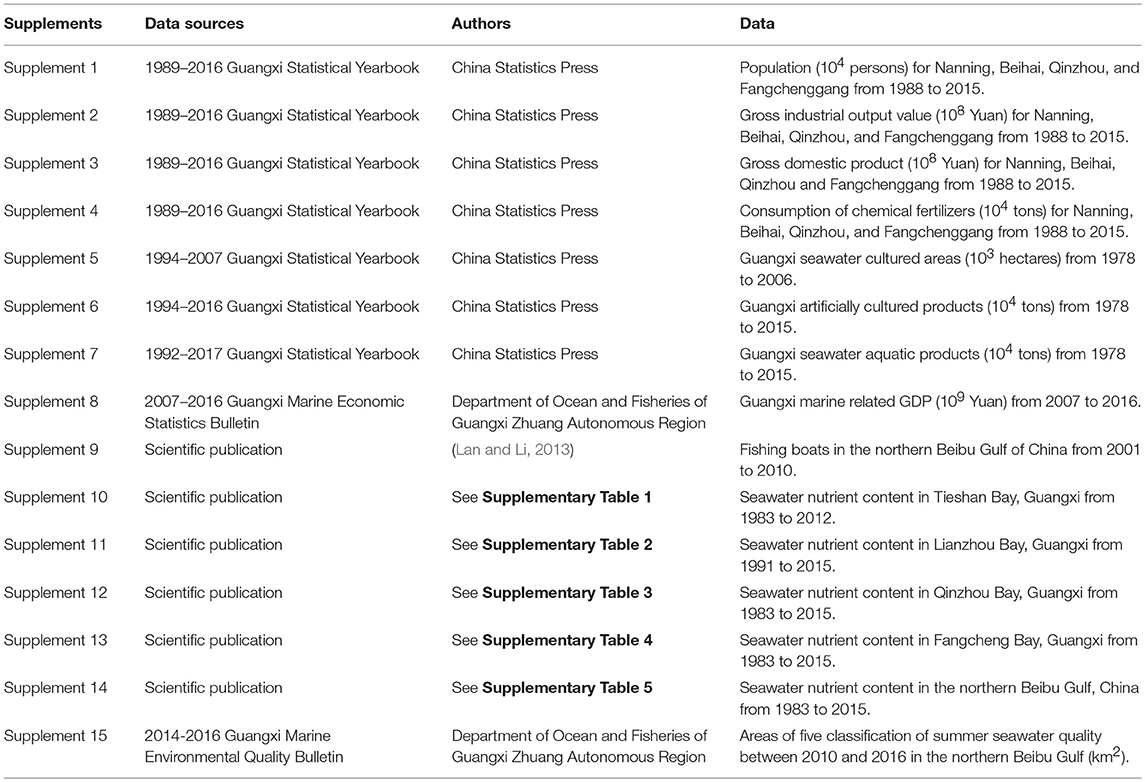
Table 2. Supplements, data sources, authors and data for (1) population, (2) gross industrial output value, (3) gross domestic product, (4) consumption of chemical fertilizers, (5) Guangxi seawater cultured areas, (6) Guangxi artificially cultured products, (7) Guangxi seawater aquatic products, (8) Guangxi marine related GDP, (9) Fishing boats in the northern Beibu Gulf of China from 2001 to 2010, (10–14) seawater nutrient content of NO3, NO2, NH4, PO4, SiO3, dissolved inorganic nitrogen (DIN), and Chemical Oxygen Demand (COD) in Tieshan Bay, Lianzhou Bay, Qinzhou Bay, Fangcheng Bay and the northern Beibu Gulf of China from 1983 to 2015, and (15) areas of five classification of summer seawater quality between 2010 and 2016 in the northern Beibu Gulf.
The seawater quality data containing the five classifications of summer seawater quality from 2010 to 2016 came from the 2014–2016 marine environmental quality bulletin of Guangxi, released by the Department of Ocean and Fisheries of the Guangxi Zhuang Autonomous Region. It was examined and classified according to the seawater quality standard of China (GB3097-1997), and was categorized from I to IV, where Grade I is defined as high quality seawater for ocean fishing, and marine nature reserves that contain rare and endangered marine organisms. Grade II is used for aquaculture, bathing beaches, and seawater activity areas with direct human contact, and also for industrial water use in relation to human consumption. Grade III is defined as general industrial water and coastal scenic areas, while Grade IV represents the worst quality seawater used for harbor and ocean engineering operations.
We used one-way ANOVA in SPSS (v. 13.0) (Chicago, Illinois, USA) to evaluate differences in environmental parameters during three time periods (1985–2000; 2001–2010; and 2011–2017) at the p < 0.05 or p < 0.01 level. Correlations between HAB outbreaks and physicochemical factors based on euclidean distance were calculated using principal component analysis and visualized using R software (v2.15.1, www.r-project.org). The relationship between the environmental factors, human activities, and HAB events from 1985 to 2017 was measured using multivariate correlation analysis (redundancy analysis), which was performed using the Canoco software package for Windows (v4.5) (Ithaca, New York, USA) with Monte Carlo permutation tests (499 permutations) (Terbraak and Smilauer, 2002; Legendre et al., 2011). HAB-causing species and environmental parameters used in the redundancy analysis were normalized through a logarithmic transformation (log10 (n+1)). We used variation partitioning analysis (VPA) to analyze the relative contribution of multiple parameters (industrial development, ID; environmental factors, EF; and human activities, HA) to HAB variation. The data came from Table 2 as defined in Data section. These data were (log2 (x+1)) transformed for standardization. VPA was performed using the VEGAN package in R.
There were 39 algal bloom events from 1985 to 2017, 15.4% occurred during the period 1985–2000, 33.3% during 2001–2010, and 51.3% during 2011–2017 (Figures 2A,B). The maximum area of algal blooms increased from >50 km2 in the 1990s to 250 km2 in the 2000s, and then HABs covered almost the entire coast between 2011 and 2017 (Table 1). Unfortunately, the area values between 2012 and 2017, when HABs became widespread, are not available. HAB duration was relatively short, occurring over days during the period 1985–2000; however, they typically occurred for weeks in the latter periods (Table 1).
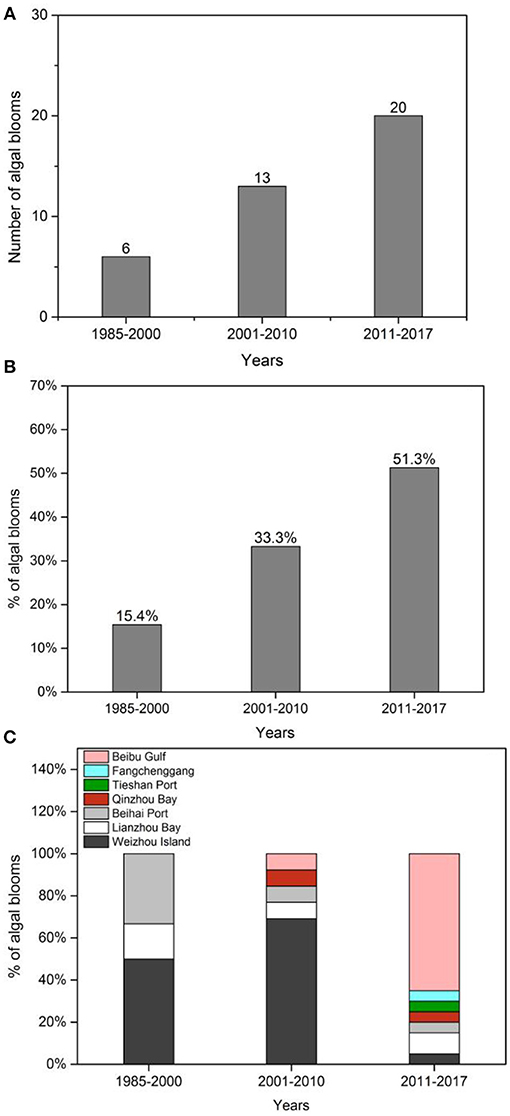
Figure 2. Number (A) and proportion (%) (B) of algal blooms reported in the northern Beibu Gulf of China from 1985–2017; (C) proportion (%) of algal blooms at different locations in the northern Beibu Gulf of China from 1985 to 2017.
Prior to 2000, HABs tended to occur at Beihai Port, Lianzhou Bay, and Weizhou Island; during the period 2001–2010, 70% of HABs occurred at Weizhou Island; and after 2011, HABs occurred at a greater number of sites, including along the coasts of Tieshan, Beihai, Qinzhou, Fangchenggang, and Weizhou Island (Figure 2C).
The causative microalgae included the cyanobacteria Trichodesmium erythraeum and Microcystis spp., with M. aeruginosa as the dominant species during the period 1985–2000. Blooms of cyanobacteria T. hildebrandtii, T. erythraeum, and M. flos-aquae, dinoflagellate Noctiluca scintillans, and diatoms Skeletonema costatum and Guinardia flaccida co-occurred without an obviously dominant species for the period 2001–2010. Between 2011 and 2017, the haptophyte P. globosa was the major species in blooms, particularly in the past 5 years (Table 1). We noticed that 4 of the 39 algal bloom events were associated with mortality of marine organisms such as fish and shrimp, and were attributed to T. erythraeum blooms in May 2001, July 2003, and June 2004 around Weizhou Island, and a N. scintillans bloom in Qinzhou in April 2011 (China Ocean Yearbook Editorial Committee, 2003, 2004; Beihai Chorography Office, 2005; State Oceanic Administration People's Republic of China, 2009; Luo et al., 2016).
Nanning, Qinzhou, Beihai, and Fangchenggang are the main districts in the Beibu Gulf Economic Zone. During the period 1980s−2015, across the districts there were 3.2–68.0, 98.1–22,703.3, 113.4–868.0, and 15.2-20,733.3-fold increases in population, gross industrial output value, gross domestic product, and fertilizer, respectively (Figures 3A–D). Nevertheless, these parameters were quite stable until the 1990s, when the substantial increases started. Although Nanning and Qinzhou generally reached much higher values than Beihai and Fangchenggang since the 2000s, all maximum fold increases were found in Fangchenggang due to its small initiating values in the 1980s.
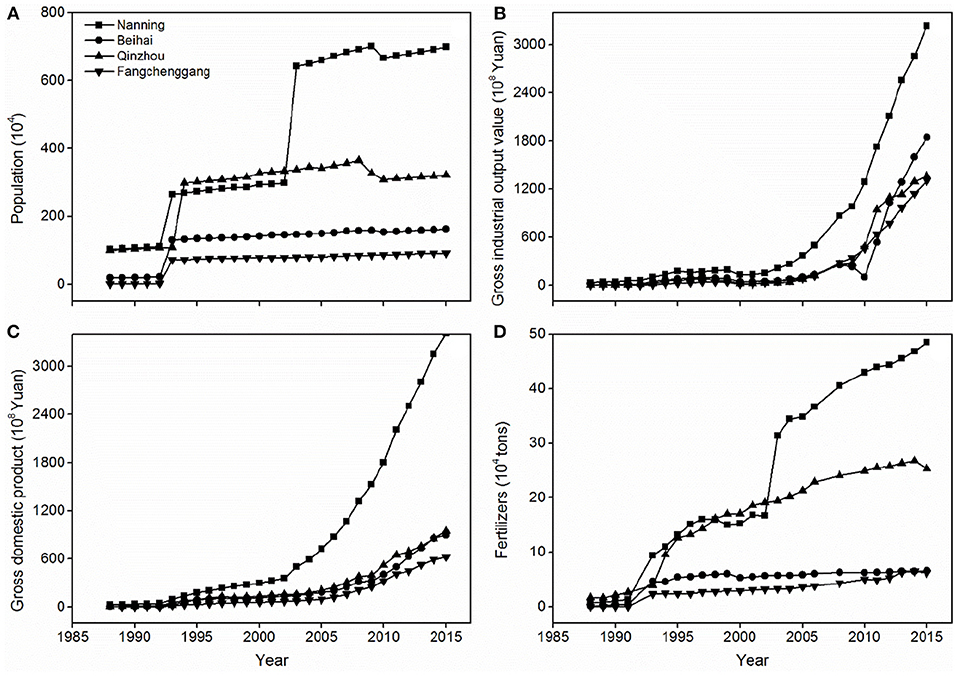
Figure 3. Time-series plots of (A) population (104), (B) gross industrial output value (108 Yuan), (C) gross domestic product (108 Yuan), and (D) fertilizers (104 tons) in four key regions of the Guangxi Beibu Gulf Economic Zone.
The seawater cultured area increased 33.6-fold from 1978 to 2006; artificially cultured products and seawater aquatic products increased by 2,607.9- and 21.7-fold, respectively, from 1978 to 2015 (Figures 4A–C), with these parameters exhibiting a significant increase after the 1990s. There was an associated 3.9-fold increase in marine related GDP from 2007 to 2016 across the region (Figure 4D). Shipping transport in the northern Beibu Gulf intensified, with increases in the number of fishing boats (from 500 in 2001 to 3,850 in 2010) and effluent (3.74-fold increase from 2001 to 2010) (Figure 5).
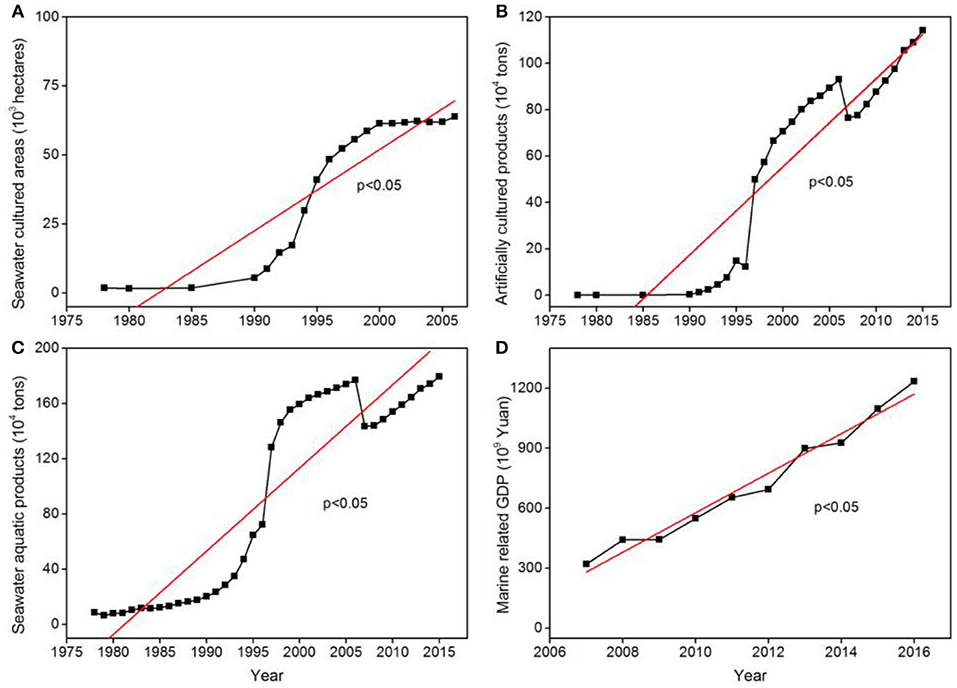
Figure 4. Time-series plots of (A) seawater cultured areas (103 hectares), (B) artificially cultured products (104 tons), (C) seawater aquatic products (104 tons), and (D) marine related GDP (109 Yuan) in the northern Beibu Gulf. Red line denotes change in trend. For p < 0.05, at the 0.05 level, the slope is significantly different from zero; for p > 0.05, at the 0.05 level, the slope is not significantly different from zero.
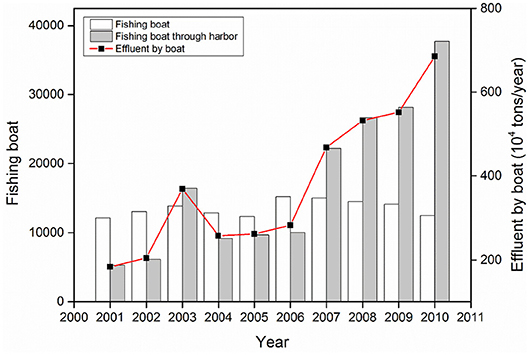
Figure 5. Number of fishing boats and harbored fishing boats, and amount of effluent produced by boat in the northern Beibu Gulf of China from 2001 to 2010.
We found significant increases in the levels of DIN, NO3, NO2, NH4, and PO4 (p < 0.05) in the study region (Figure 6). From 1980 to 2010, there were 17.9-, 12.7-, 33.5-, and 1.5-fold increases in average DIN, NO3, NO2, and NH4 in the northern Beibu Gulf, respectively (Table 3). From 1990 to 2010, average PO4 increased almost 2-fold, and there were no significant differences in concentrations of SiO3 and COD (p > 0.05), although both were lowest in the 1980s (Figure 6, Table 3). Maximum concentrations of SiO3 in the northern Beibu Gulf increased from 81.0 μM in the 1980s to 113.0 μM in the 1990s, and to 167.1 μM in the 2000s, while maximum COD increased from 2.7 mg/L in the 1980s to 7.5 mg/L in 2010s (Figure 6).
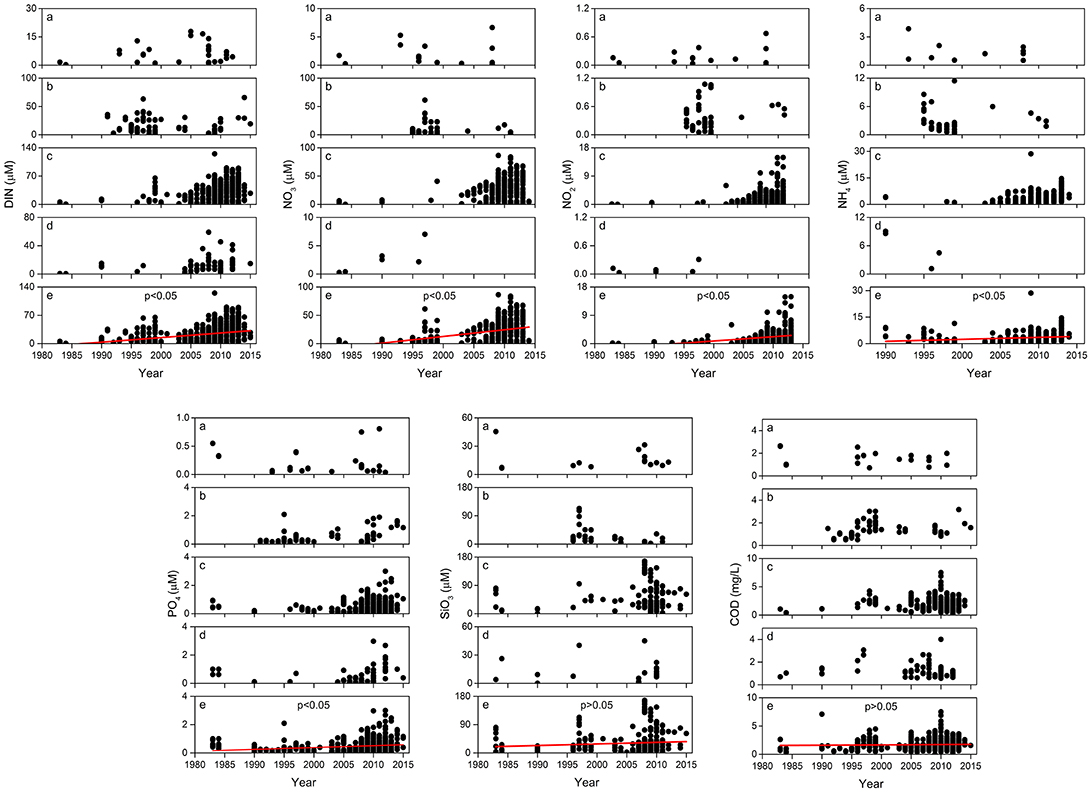
Figure 6. Temporal changes in seawater nutrient content between 1980 and 2015 in (a) Tieshan Bay; (b) Lianzhou Bay; (c) Qinzhou Bay; (d) Fangcheng Bay; and, (e) Beibu Gulf, where n = 697, 456, 453, 442, 708, 278, and 560 for linear fit of DIN, NO3, NO2, NH4, PO4, SiO3, and COD, respectively, and the red line denotes the long term trend. For p < 0.05, at the 0.05 level, the slope is significantly different from zero; for p > 0.05, at the 0.05 level, the slope is not significantly different from zero.

Table 3. Long term trend in seawater nutrient (μM) and COD (mg/L) content in the northern Beibu Gulf. Data are means ±SD.
There was a deterioration in summer seawater quality between 2009 and 2016, with a generally increasing trend in the area of seawater with quality ranked in the lowest category (Grade IV), quality worse than Grade IV, and quality lower than Grade I during 2011–2015 (Figure 7).
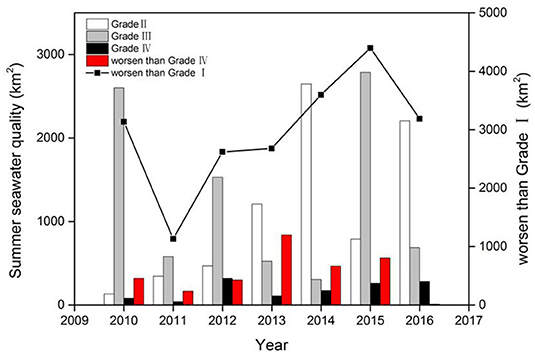
Figure 7. Summer seawater quality between 2009 and 2016 in the northern Beibu Gulf. Seawater quality is categorized from I–IV, where Grade I is defined as high quality seawater for ocean fishing, marine nature reserves that contain rare and endangered marine organism, while Grade IV represent the worst quality seawater used for harbor and ocean engineering operations.
We found there were temporal trends in multiple factors influencing HAB events (Figure 8A): between 1985 and 2000, there was an association with , seawater aquatic products, and marine related GDP value; while between 2001 and 2010, there was an association with artificially cultured products, fertilizer use, gross domestic product, and C-N-P-Si sources (such as COD, NO3, PO4, and SiO3). Between 2011 and 2017 there was an association between HAB events and NO3, NO2, COD, PO4, fishing activities, seawater quality, population number, industrial development, and mariculture.
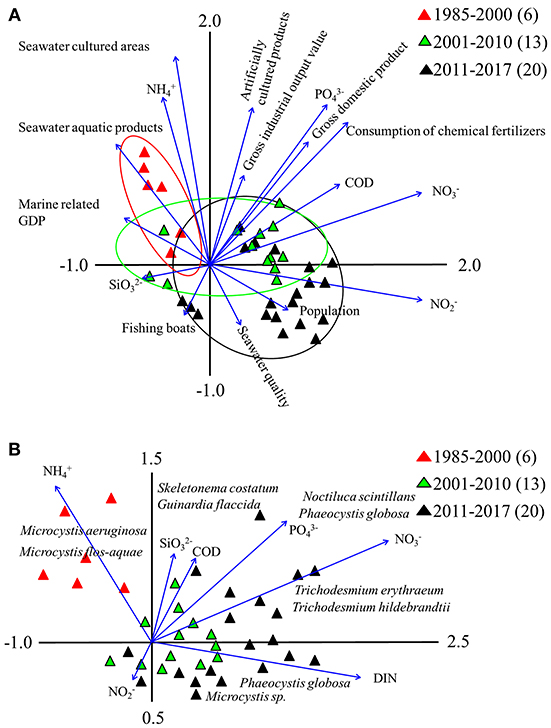
Figure 8. Principal component analysis (A) and redundancy analysis (B) of industrial development, environmental factors, human activities and HAB events at sampling stations from 1985 to 2017 in the study region. Arrow length indicates importance of each factor in HAB events.
For simplification, we used nutrients as the target in the redundancy analysis, and found that there was temporal variation in the dominant phytoplankton species (Figure 8B). Succession of algae tended to be driven by N and P content, and the two dominant species in earlier years, M. aeruginosa and M. flos-aquae, showed a preference for high levels of NH4. Two species prominent from 2001 to 2010, S. costatum and G. flaccida, were closely associated with SiO3 and COD. Other dominant species, Trichodesmium spp. and N. scintillans showed association with high levels of NO3 and PO4, and we found that DIN and PO4 influenced P. globosa abundance.
VPA showed that when combined, ID, EF, and HA explained 65.7% of the variation in HAB outbreaks (Figure 9), whereas independently, ID, EF, and HA explained 14.7% (p < 0.05), 20.6% (p < 0.05), and 13.2% (p < 0.05) of the variation, respectively. Interactions between ID and EF, EF and HA, and HA and ID explained 7.1, 4.9, and 5.2% of variation, respectively. Overall 34.3% of variation in HAB events was not explained by these parameters.
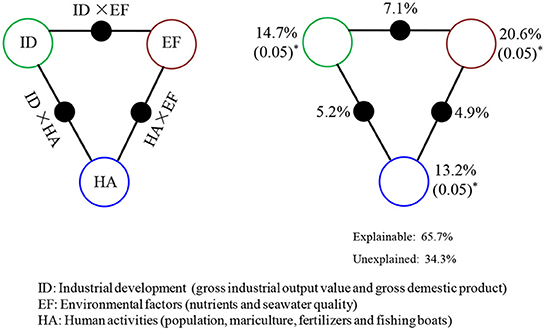
Figure 9. Variation partitioning analysis (VPA) of HAB events explained by multiple influencing factors including industrial development, ID; environmental factors, EF; and human activities, HA. The angles and sides of the triangles represent the variation explained by each single factor and by the combination of any two factors, respectively.
Similar to many coastal regions globally, HABs in the northern Beibu Gulf have significantly increased in frequency, duration, geographical distribution, and degree of harm in recent decades (Anderson et al., 2002; Heisler et al., 2008). However, compared with already developed Chinese coastal areas such as the Bohai estuary and Changjiang River Estuary, there was an ~ 10–15 year lag for the remarkable breakout of HABs in the northern Beibu Gulf (Luo et al., 2016; Yu and Liu, 2016; Song et al., 2018). Most anthropogenic activities surveyed in this study increased substantially by the late 1990s, when HAB frequency started to increase exponentially. It is thus likely anthropogenic activities play crucial roles in the occurrence of HABs in the region. Similar increases in HAB frequencies linked to anthropogenic activities, population, and industrial development were reported as early as 1976–1986 in Tolo Harbor, Hong Kong and 1965–1976 in the Seto Inland Sea of Japan (Lam and Ho, 1989; Okaichi, 1989). We thus speculate that the trend in HAB events in the northern Beibu Gulf is extremely likely to follow HAB patterns in already polluted coastal waters and will therefore further intensify if HAB mitigation and management strategies are not carried out in the near future.
Among the locations, Weizhou Island was the algal blooms hot spot prior to 2010, but blooms occurrences near the island subsequently declined while blooms increased in nearshore waters along the entire Beibu Gulf coast. The volcanic Weizhou Island is a natural source of trace metals such as iron and manganese, and nutrients N and P (Li and Lai, 2007), and the southwest monsoon in the Indian Ocean, which brings high temperatures and strong rainfall to the region, washes terrestrial nutrients into the nearshore waters, which fuels algal blooms. Nutrient-rich seawater passes through the Qiongzhou Strait in the northern Beibu Gulf all year round and elicited a stronger effect on HABs at Weizhou Island than in the bays of Beihai, Qinzhou, and Fangcheng, because summer seawater upwelling delivers abundant nutrients to the sea surface near the island (Yang et al., 2006; Shi, 2014). Most HABs occur at the southern part of Weizhou Island which is the main location for industrial and mariculture activities, and has a dense population that has polluted the coastline (Qiu et al., 2005; He et al., 2013; Li et al., 2014a; Dou et al., 2015). Finally, the nutrient structure in Weizhou Island has changed from N limitation (N:P = 4.1) in the beginning of the 1990s (Wei et al., 2005) to P limitation (N:P = 38.1) in the late 2000s (Sun et al., 2010; He et al., 2013), which may partly explain the decline in HABs after the 2000s.
There were also changes in the ratios of Si:N:P in the northern Beibu Gulf over the study period, the N:P ratio increased from 2.9 to 6.5 in the 1980s to 24.8 to 202.6 in the 1990s in Qinzhou Bay (Wei et al., 2002a), similar trends have been recorded in Tieshan Bay and Lianzhou Bay (Wei et al., 2002b; Lan et al., 2014; Yang et al., 2015). These shifts from N limitation to N abundance, with relative sufficiency of Si, and P limitation (Wu, 2014; Wang F. et al., 2015; Yang et al., 2015) are likely to have changed algal species composition in marine ecosystems (Glibert, 2017). This may explain the recent dominance of Phaeocystis blooms in the region, in accordance with the substantial N requirements of P. globosa to support its proliferation and sustained blooms (Xu et al., 2003; Zheng, 2014; Gong et al., 2018).
Temporal shifts in dominant HAB species driven by nutrient conditions have been widely seen in Chinese waters. Changjiang River estuary, the most notable HAB area in China, has experienced an obvious change of dominant blooming microalgae from diatoms to noxious or toxic dinoflagellates in the last 30 years (Yang et al., 2015; Yu et al., 2017). This shift was thought to be largely driven by the increasing ratio of DIN:P and high DIN, which increased 4-fold from 20.5 μM in the 1960s to 80.0 μM in the 2000s (Ye et al., 2004; Wang and Cao, 2012; Yu et al., 2017). During 2009–2016, the proportion of dinoflagellate blooms has also risen to as high as 79% on the south China coast, induced by changes in seawater temperature, DIN, and P concentration (Yi et al., 2018). Changes in phytoplankton communities may also relate to climate change (Hallegraeff, 2010; Wells and Karlson, 2018), which needs to be investigated in the future for the northern Beibu Gulf.
The haptophyte Phaeocystis forms massive HABs in many parts of the world, from tropical and subtropical to Arctic and Antarctic oceans (Long et al., 2007; Smith et al., 2017). This bloom is recognized both as a nuisance and as an ecologically important phytoplankton, with production of haemolytic substances in relation to the risk of marine life and human health, as well as dimethylsulfide (DMS) involved in the biological regulation of the climate (Medlin and Zingone, 2007; Wang S. et al., 2015). So far, six Phaeocystis species have been clearly defined, and only three of them, P. globosa, P. pouchetii, and P. antarctica, were described to date as bloom forming species (Schoemann et al., 2005; Medlin and Zingone, 2007). However, in Chinese seawaters P. globosa is the only bloom causing organism within this genus to date, with its blooms first documented from Oct 1997-Feb 1998 in southeast China, covering thousands of km2 in the coastal waters of Fujian and Guangdong (Chen et al., 1999; Qi et al., 2002). It then frequently appeared in southern coastal areas (Hainan, Hong Kong, and Guangdong), and Bohai and Yellow River estuaries from 2000 to 2009 (Qi et al., 2002; Li et al., 2012). Blooms of P. globosa started to occur from 2011 in the northern Beibu Gulf and have continued breaking out in recent years (Table 1). Phaeocystis has a complex polymorphic life cycle alternating between flagellated cells and colonies enclosed in an exopolysaccharide matrix (Rousseau et al., 2013), protecting it from predators, enhanced UVB, and viral and bacterial infections (Brussaard et al., 2005; Kennedy et al., 2012). Interestingly, Phaeocystis develops blooms in the colonial form, particularly in waters with abundant nitrates, phosphate, and urea (Schoemann et al., 2005; Wang et al., 2007; Liang et al., 2018). In addition to the advantages of colony morphology, another competitive advantage of P. globosa in the northern Beibu Gulf may be its environmental adaptations, such as high tolerance of varied environmental light, preference for high temperatures and flexible nutrient uptake strategy (Schoemann et al., 2005; Xu et al., 2017).
Both abiotic and biotic factors affect the formation and duration of HAB events (Smith et al., 1999; Lewitus et al., 2012; Smetacek, 2012; Smida et al., 2012). In this study, about 65.7% of HAB variation was explained by human activity factors, environmental factors, and industrial development, indicating that these parameters are dominant determinants of HAB formation. Our findings support the previous viewpoint that abiotic factors are the main drivers affecting algal bloom formation and community structure (Worden et al., 2015). On the other hand, we note that 34.3% of HAB variation was not explained by the data measured, which indicates that other abiotic (water chemistry and hydrodynamics) and/or biotic (algal species interactions, viral lysis, reactive oxygen species abundance, and fungal and zooplankton predation) factors that were not included in this analysis may be important drivers of HAB events (Sun et al., 2017; Karasiewicz et al., 2018; Zhang et al., 2018). Further investigation of the interactions among algae, bacteria, viruses, and ciliates, particularly their network relationship over longer time scales, is needed to better characterize the underlying mechanisms driving the increases in HAB events and phytoplankton community variation in the northern Beibu Gulf.
Algal blooms in the northern Beibu Gulf have intensified over the past three decades, likely as a result of anthropogenic influences. Continuing economic and industrial development, as well as a rising human population in the region, will lead to further increases in HAB events in the future. Thus, HAB mitigation strategies should include: (1) an increase in the number of buoys and automatic monitoring stations along the northern Beibu Gulf coast; (2) the development of satellite remote sensing, in situ cell observations, and computer modeling to predict bloom events; (3) reductions in nutrient discharge and/or improved management for N/P removal; and, (4) the creation of a science-based ecological management plan to perform the ecophysiological and toxicological characterization of regional algal bloom species. There should be government-level efforts to enrich database records of HAB events and analyze the key environmental drivers of HABs to improve the sustainable development of this region.
YX and TZ collect the data and designed the experiments. YX and JZ contributed to the analyses work. The manuscript was first written by YX and TZ, and then improved by YX and JZ.
This work was funded by the National Natural Science Foundation of China (41506137, 41661021 and 41361022), Natural Science Foundation of Guangxi (2016GXNSFBA380037 and 2016JJF15001), the Opening Foundation of Key Laboratory of Environment Change and Resources Use in Beibu Gulf Ministry of Education (Guangxi Teachers Education University), and the Guangxi Key Laboratory of Earth Surface Processes and Intelligent Simulation (Guangxi Teachers Education University) (GTEU-KLOP-K1805).
The authors declare that the research was conducted in the absence of any commercial or financial relationships that could be construed as a potential conflict of interest.
The Supplementary Material for this article can be found online at: https://www.frontiersin.org/articles/10.3389/fmicb.2019.00451/full#supplementary-material
Anderson, D. M., Alpermann, T. J., Cembella, A. D., Collos, Y., Masseret, E., and Montresor, M. (2012). The globally distributed genus Alexandrium: multifaceted roles in marine ecosystems and impacts on human health. Harmful Algae 14, 10–35. doi: 10.1016/j.hal.2011.10.012
Anderson, D. M., Glibert, P. M., and Burkholder, J. M. (2002). Harmful algal blooms and eutrophication: nutrient sources, composition, and consequences. Estuaries 25, 704–726.
Beihai Chorography Editorial Committee (2012). 2012 Beihai Yearbook. Nanning: Guangxi People's Publishing House. 350 (in Chinese).
Beihai Chorography Office (2005). 2005 Beihai Yearbook. Nanning: Guangxi People's Publishing House. 314 (in Chinese).
Beihai Yearbook Editorial Committee (1997). 1997 Beihai Yearbook. Nanning: Guangxi People's Publishing House. 183 (in Chinese).
Beihai Yearbook Editorial Committee (2003). 2003 Beihai Yearbook. Nanning: Guangxi People's Publishing House. 217 (in Chinese).
Brussaard, C. P. D., Kuipers, B., and Veldhuis, M. J. W. (2005). A mesocosm study Phaeocystis globosa population dynamics I. Regulatory role of viruses in bloom control. Harmful Algae 4, 859–874. doi: 10.1016/j.hal.2004.12.015
Cao, X., Yu, Z., and Qiu, L. (2017). Field experiment and emergent application of modified clays for Phaeocystis globosa blooms mitigation. Oceanol. Et Limnologia Sin. 48, 753–759 (in Chinese). doi: 10.11693/hyhz20170200026
Chen, J., Xu, N., Jiang, T., Wang, Y., Wang, C., and Qi, Y. (1999). A report of phaeocystis globosa bloom in coastal water of southeast China. J. Jinan Univer. 20, 124–129 (in Chinese).
Chen, Z., Cai, W., Xu, S., Huang, Z., and Qiu, Y. (2011). Risk assessment of coastal ecosystem in Beibu Gulf, Guangxi of South China. Chinese J. Appl. Ecol. 22, 2977–2986. doi: 10.13287/j.1001-9332.2011.0416
China Ocean Yearbook Editorial Committee (2002). 2001 China Ocean Yearbook. Beijing: China Ocean Press, 372 (in Chinese).
China Ocean Yearbook Editorial Committee (2003). 2002 China Ocean Yearbook. Beijing: China Ocean Press, 181 (in Chinese).
China Ocean Yearbook Editorial Committee (2004). 2003 China Ocean Yearbook. Beijing: China Ocean Press, 213 (in Chinese).
China Oceanic Information Network (2011). 2003 Marine Environmental Quality Bulletin of Guangxi: Red Tides. Available online at: http://www.nmdis.org.cn/gongbao/nrhuanjing/nryanhai/nr2003/nr03guangxi/201107/t20110729_18394.html (Accessed Mar 1, 2019). (in Chinese).
Dou, Y., Gao, J., Shi, X., Chen, R., and Zhou, W. (2015). Outbreak frequency and factors influencing red tides in nearshore waters of the South China Sea from 2000 to 2013. J. Hydroecol. 36, 31–27 (in Chinese). doi: 10.15928/j.1674-3075.2015.03.005
Glibert, P. M. (2017). Eutrophication, harmful algae and biodiversity—Challenging paradigms in a world of complex nutrient changes. Mar. Poll. Bull. 124, 591–606. doi: 10.1016/j.marpolbul.2017.04.027
Glibert, P. M., Al-Azri, A., Icarus Allen, J., Bouwman, A. F., Beusen, A. H. W., Burford, M. A., et al. (2018). “Key questions and recent research advances on harmful algal blooms in relation to nutrients and eutrophication,” in Global Ecology and Oceanography of Harmful Algal Blooms, eds P. M. Glibert, E. Berdalet, M. A. Burford, G. C. Pitcher, and M. Zhou (Cham: Springer), 229–259. doi: 10.1007/978-3-319-70069-4_12
Gong, B., Wu, H., Ma, J., Luo, M., and Li, X. (2018). The algae community in taxon Haptophyceae at the early bloom stage of Phaeocystis globosa in Northern Beibu Gulf in winter. BioRxiv [preprint]. doi: 10.1101/492454
Hallegraeff, G. M. (2010). Ocean climate change, phytoplankton community responses, and harmful algal blooms: a formidable predictive challenge. J. Phycol. 46, 220–235. doi: 10.1111/j.1529-8817.2010.00815.x
He, B., Li, G., Wei, M., and Tan, Q. (2013). Relationship between the seasonality of seawater N:P ratio and the structure of plankton on the reefs of Weizhou Island, northern South China Sea. J. Trop. Oceano. 32, 64–72 (in Chinese). doi: 10.3969/j.issn.1009-5470.2013.04.010
Heisler, J., Glibert, P. M., Burkholder, J. M., Anderson, D. M., Cochlan, W., Dennison, W. C., et al. (2008). Eutrophication and harmful algal blooms: a scientific consensus. Harmful Algae 8, 3–13. doi: 10.1016/j.hal.2008.08.006
Kaiser, D., Unger, D., Qiu, G., Zhou, H., and Gan, H. (2013). Natural and human influences on nutrient transport through a small subtropical Chinese estuary. Sci Total. Environ. 450–451, 92–107. doi: 10.1016/j.scitotenv.2013.01.096
Karasiewicz, S., Breton, E., Lefebvre, A., Fariñas, T. H., and Lefebvre, S. (2018). Realized niche analysis of phytoplankton communities involving HAB: Phaeocystis spp. as a case study. Harmful Algae 72, 1–13. doi: 10.1016/j.hal.2017.12.005
Kennedy, F., McMinn, A., and Martin, A. (2012). Effect of temperature on the photosynthetic efficiency and morphotype of Phaeocystis antarctica. J. Exp. Marine Biol. Ecol. 429, 7–14. doi: 10.1016/j.jembe.2012.06.016
Lai, J., Jiang, F., Ke, K., Xu, M., Lei, F., and Chen, B. (2014). Nutrients distribution and trophic status assessment in the northern Beibu Gulf, China. Chin. J. Oceanol. Limnol. 32, 1128–1144. doi: 10.1007/s00343-014-3199-y
Lam, C. W., and Ho, K. (1989). “Red tides in Tolo Harbour, Hong Kong,” in Red tides, Biology Environmental Science and Toxicology, eds T. Okaichi, D. M. Anderson, and T. Nemoto (New York, NY: Elsevier), 49–52.
Lan, W., and Li, T. (2013). Problems and countermeasures of marine ecosystem Qinzhou Bay. Environ. Sci. Manage. 38, 118–122 (in Chinese). doi: 10.3969/j.issn.1673-1212.2013.01.029
Lan, W., Li, T., and Han, L. (2014). Distribution and seasonal variation of nutrition in the adjacent waters of Tieshangang bay in Guangxi. Marine Sci. 38, 63–69 (in Chinese). doi: 10.11759/hykx20100812001
Legendre, P., Oksanen, J., and Braak, C. J. F. T. (2011). Testing the significance of canonical axes in redundancy analysis. Method. Ecol. Evol. 2, 269–277. doi: 10.1111/j.2041-210X.2010.00078.x
Lewitus, A. J., Horner, R. A., Caron, D. A., Garcia-Mendoza, E., Hickey, B. M., Hunter, M., et al. (2012). Harmful algal blooms along the North American west coast region: history, trends, causes, and impacts. Harmful Algae 19, 133–159. doi: 10.1016/j.hal.2012.06.009
Li, B., Lan, W., Li, T., and Li, M. (2015a). Variation of environmental factors during Phaeocystis globosa blooms and its implications for the bloom decay. Chinese J. Ecol. 34, 1351–1358 (in Chinese). doi: 10.13292/j.1000-4890.20150311.050
Li, F., and Lai, C. (2007). Investigations on red tide in the sea area of Guangxi and countermeasures. Environ. Sci. Manage. 32, 76–109 (in Chinese). doi: 10.3969/j.issn.1673-1212.2007.09.023
Li, S., Xu, S., Liang, M., and He, G. (2014b). Research on marine environmental protection and the management of the Beibu Gulf in Guangxi. J. Qinzhou Univer. 29, 1–5 (in Chinese).
Li, T., Lan, W., Lu, Y., and Xie, X. (2015b). Application of automatic monitoring buoy in early warning for algal blooms in offshore area. Marine Forecasts 32, 70–78 (in Chinese). doi: 10.11737/j.issn.1003-0239.2015.01.011
Li, T., Li, Y., Lai, C., Ning, Y., and Lu, Y. (2011). Analyze red tide with automatic monitoring system of water quality in Lianzhou Gulf. Environ. Monitor. China 27, 32–35 (in Chinese). doi: 10.3969/j.issn.1002-6002.2011.04.008
Li, X., Zhang, J., and Liu, G. (2009). Studies of a Trichodesmium erythraeum red tide in sea area near Weizhou Island Guangxi. Guangxi Sci. 16, 188–192 (in Chinese). doi: 10.13656/j.cnki.gxkx.2009.02.017
Li, Y., Shen, P., Huang, L., and Qi, Y. (2012). Taxonomy and phylogenetics of genus Phaeocystis: Research progress. Chin. J. Ecol. 31, 745–754 (in Chinese). doi: 10.13292/j.1000-4890.2012.0153
Li, S., Dai, Z., Ge, Z., Xie, H., and Huang, H. (2014a). Research on the changes of the ecological environment disasters along the northern Beibu Gulf. J. Catastrophol. 29, 43–47 (in Chinese). doi: 10.3969/j.issn.1000-811X.2014.04.009
Liang, D., Wang, X., and Wang, Y. (2018). Effects of different nitrogen on the growth and the formation of colony in phaeocystis globosa. Adv. Marine Sci. 36, 272–278 (in Chinese). doi: 10.3969/j.issn.1671-6647.2018.02.012
Liang, S., and Qian, H. (1991). Relationship between harmful algal blooms and monsoon transform in the north of South China Sea. Res. Dev. South China Sea 3, 1–5 (in Chinese).
Lindh, M. V., Riemann, L., Baltar, F., Romero-Oliva, C., Salomon, P. S., Granéli, E., et al. (2013). Consequences of increased temperature and acidification on bacterioplankton community composition during a mesocosm spring bloom in the Baltic Sea. Environ. Microbiol. Rep. 5, 252–262. doi: 10.1111/1758-2229.12009
Long, J. D., Frischer, M. E., and Robertson, C. Y. (2007). A phaeocystis globosa bloom associated with upwelling in the subtropical South Atlantic Bight. J. Plankton Res. 29, 769–774. doi: 10.1093/plankt/fbm058
Luo, J., Li, T., and Lan, W. (2016). Evolution trend and prevention strategy of algae bloom in the Beibu Gulf. Environ. Protec. 20, 40–42 (in Chinese). doi: 10.14026/j.cnki.0253-9705.2016.20.008
Marine Environmental Monitoring Center of Beihai Guangxi (2006). 2001-2005 Report on Coastal Seawater Quality of Guangxi (in Chinese).
Medlin, L., and Zingone, A. (2007). A taxonomic review of the genus phaeocystis. Biogeochemistry 83, 3–18. doi: 10.1007/s10533-007-9087-1
News China (2011). Red tide appears in part of Beibu Gulf of Guangxi. Available online at: http://news.xinhuanet.com/fortune/2011-11/10/c_111158418.htm (Accessed May 12, 2018). (in Chinese).
Okaichi, T. (1989). “Red tide problems in the Seto Inland Sea, Japan,” in Red tides, Biology Environmental Science and Toxicology, eds T. Okaichi, D. M. Anderson, and T. Nemoto (New York, NY: Elsevier), 137–142.
Qi, Y., Xu, N., Wang, Y., Lu, S., and Chen, J. (2002). Progress of studies on red tide in China—Studies on Phaeocystis globosa red tide and its DMS (DMSP) production. China Basic Sci. 4, 23–27 (in Chinese). doi: 10.3969/j.issn.1009-2412.2002.04.005
Qiu, S., Lai, T., and Zhuang, J. (2005). A case analysis of the Microcystis aeruginosa red tide occurring in the sea field of Nanwan harbor, Weizhou Island. Guangxi Sci. 12, 330–333 (in Chinese). doi: 10.13656/j.cnki.gxkx.2005.04.026
Rousseau, V., Lantoine, F., Rodriguez, F., LeGall, F., Chrétiennot-Dinet, M., and Lancelot, C. (2013). Characterization of Phaeocystis globosa (Prymnesiophyceae), the blooming species in the Southern North Sea. J. Sea. Res. 76, 105–113. doi: 10.1016/j.seares.2012.07.011
Schoemann, V., Becquevort, S., Stefels, J., Rousseau, V., and Lancelot, C. (2005). Phaeocystis blooms in the global ocean and their controlling mechanisms: a review. J. Sea Res. 53, 43–66. doi: 10.1016/j.seares.2004.01.008
Shi, M. (2014). Study comments on circulation in Beibu Gulf. Guangxi Sci. 21, 313–324 (in Chinese). doi: 10.13656/j.cnki.gxkx.2014.04.001
Smetacek, V. (2012). Making sense of ocean biota: how evolution and biodiversity of land organisms differ from that of the plankton. J. Biosci. 37, 589–607. doi: 10.1007/s12038-012-9240-4
Smida, D. B., Sahraoui, I., Mabrouk, H. H., and Hlaili Sakka, A. (2012). Seasonal dynamics of genus Alexandrium (potentially toxic dinoflagellate) in the lagoon of Bizerte (North of Tunisia) and controls by the abiotic factors. Cri. Rev. Biol. 335, 406–416. doi: 10.1016/j.crvi.2012.04.007
Smith, V. H., Tilman, G. D., and Nekola, J. C. (1999). Eutrophication: impacts of excess nutrient inputs on freshwater, marine, and terrestrial ecosystems. Environ. Pollut. 100, 179–196.
Smith, W. O., Jr, McGillicuddy., D. J, Jr., Olson, E. B., Kosnyrev, V., et al. (2017). Mesoscale variability in intact and ghost colonies of Phaeocystis antarctica in the Ross Sea: Distribution and abundance. J. Marine Syst. 166, 97–107. doi: 10.1016/j.jmarsys.2016.05.007
Song, N., Wang, N., Wu, N., and Lin, W. (2018). Temporal and spatial distribution of harmful algal blooms in the Bohai Sea during 1952~2016 based on GIS. China Environ. Sci. 38, 1142–1148 (in Chinese). doi: 10.19674/s.cnki.issn1000-6923.2018.0136
Southland Morning Post (2002). Red Tides Invade Twice, The Clean Sea may Disappear, the Beibu Gulf of Guangxi is in Emergency. Available online at: http://news.sina.com.cn/c/2002-05-17/0908578104.html (Accessed May, 12 2018). (in Chinese).
Southland Morning Post (2015). High Frequency of Red Tides Occur in Beibu Gulf, With 18 Red Tides in 20 Years. Available at: http://gx.people.com.cn/n/2015/1222/c179430-27371761-2.html (Accessed May 12, 2018). (in Chinese).
State Oceanic Administration People's Republic of China (2009). 2008 Marine Environmental Quality Bulletin of Guangxi: Ocean Disastar. Available online at: http://www.coi.gov.cn/gongbao/nrhuanjing/nryanhai/nr2008/nr08guangxi/201107/t20110729_17976.html (Accessed May 12, 2018). (in Chinese).
Sun, J. Y., Song, Y., Ma, Z. P., Zhang, H. J., Yang, Z. D., Cai, Z. H., et al. (2017). Fungal community dynamics during a marine dinoflagellate (Noctiluca scintillans) bloom. Mar. Environ. Res. 131, 183–194. doi: 10.1016/j.marenvres.2017.10.002
Sun, Y., Chen, B., Ma, Z., and Yu, W. (2010). Assessment and cause analysis of eutrophication in the adjacent sea areas of south subtropical islands. Mar. Sci. Bull. 29, 572–576 (in Chinese). doi: 10.3969/j.issn.1001-6392.2010.05.017
Tang, D., Di, B., Wei, G., Ni, I., Oh, I. S., and Wang, S. (2006). Spatial, seasonal and species variations of harmful algal blooms in the South Yellow Sea and East China Sea. Hydrobiologia 568, 245–253. doi: 10.1007/s10750-006-0108-1
Terbraak, C. J. F., and Smilauer, P. (2002). Canoco Reference Manual and Canodraw for Windows User's Guide: Software for Canonical Community Ordination (version 4. 5). New York, NY: Microcomputer Power.
Tong, M. (2006). Classfication, Grading and Risk Assessment System of Harmful Algal Blooms in Coastal China. [master's thesis]. Jinan University, 64 (in Chinese).
Wang, F., Lin, Y., Cao, W., Zhang, W., Zheng, L., Yang, W., et al. (2015). The relationship between nutrients and phytoplankton community structure in northern Beibu Gulf. J. Trop. Oceano. 34, 73–85 (in Chinese). doi: 10.11978/2014134
Wang, J., and Cao, J. (2012). Variation and effect of nutrient on phytoplankton community in Changjiang Estuary during last 50 years. Marine Environ. Sci. 31, 310–315 (in Chinese). doi: 10.3969/j.issn.1007-6336.2012.03.002
Wang, S., Elliott, S., Maltrud, M., and Cameron-Smith, P. (2015). Influence of explicit Phaeocystis parameterizations on the global distribution of marine dimethyl sulfide. J. Geophys. Res. 120, 2158–2177. doi: 10.1002/2015JG003017
Wang, Y., Qi, Y., and Li, S. (2007). Nutritional requirements for the growth of Phaeocystis globosa scherffel. Acta Hydrobiol. Sinica 31, 24–29 (in Chinese). doi: 10.3321/j.issn:1000-3207.2007.01.004
Wei, M., and He, B. (1998). A study on eutrophication and red tide formation in Lianzhou Bay. Tropic Oceanol. 17, 65–72 (in Chinese).
Wei, M., Lai, T., and He, B. (2002a). Change trend of the chemical items in Qinzhou Bay in the last twenty yearsINutrient condition in usual discharged period. Mar. Environ. Sci. 21, 49–52 (in Chinese). doi: 10.3969/j.issn.1007-6336.2002.03.011
Wei, M., Lai, T., and He, B. (2002b). Development trend of the water quality conditions in the Tieshangang Bay. Mar. Sci. Bull. 21, 69–74 (in Chinese). doi: 10.3969/j.issn.1001-6392.2002.05.010
Wei, M., Li, G., He, B., and Liang, W. (2005). Preliminory study of the relatioship between plankton and environmental factors in the coral reef system around Weizhou Island. Trans. Oceanol. Limnol. 2, 34–39 (in Chinese). doi: 10.3969/j.issn.1003-6482.2005.02.006
Wells, M. L., and Karlson, B. (2018). “Harmful algal blooms in a changing ocean,” in Global Ecology and Oceanography of Harmful Algal Blooms, eds P. M. Glibert, E. Berdalet, M. A. Burford, G. C. Pitcher, and M. Zhou (Cham: Springer), 77–90. doi: 10.1007/978-3-319-70069-4_5
Worden, A. Z., Follows, M. J., Giovannoni, S. J., Wilken, S., Zimmerman, A. E., and Keeling, P. J. (2015). Rethinking the marine carbon cycle: factoring in the multifarious lifestyles of microbes. Science 347:1257594. doi: 10.1126/science.1257594
Wu, M. (2014). The Distribution Feature of Nutrients and the Study of their Influence on Ecosystem in the Northern Beibu Gulf. [master's thesis]. Xiamen University, 115 (in Chinese).
Xu, N., Huang, B., Hu, Z., Tang, Y., Duan, S., and Zhang, C. (2017). Effects of temperature, salinity, and irradiance on the growth of harmful algal bloom species Phaeocystis globosa Scherffel (Prymnesiophyceae) isolated from the South China Sea. Chin. J. Oceanol. Limnol. 35, 557–565. doi: 10.1007/s00343-017-5352-x
Xu, N., Qi, Y., Chen, J., Huang, W., Lv, S., and Wang, Y. (2003). Analysis on the cause of Phaeocystis globosa Scherffel red tide. Acta Sci. Circumstan. 23, 113–118 (in Chinese). doi: 10.13671/j.hjkxxb.2003.01.022
Yang, J., Zhang, R., Zhao, Z., Weng, S., and Li, F. (2015). Temporal and spatial distribution characteristics of nutrients in the coastal seawater of Guangxi Beibu Gulf during the past 25 years. Ecol. Environ. Sci. 24, 1493–1498 (in Chinese). doi: 10.16258/j.cnki.1674-5906.2015.09.011
Yang, S., Chen, B., and Li, P. (2006). A study of the characteristics of water transport from the South China Sea into Beibu Bay via the Qiongzhou Stratit in summer in terms of temperature and salinity data. Trans. Oceanol. Limnol. 1, 1–7 (in Chinese). doi: 10.3969/j.issn.1003-6482.2006.01.001
Ye, S., Ji, H., Cao, L., and Huang, X. (2004). Red tides in the Yangtze River Estuary and adjacent sea areas: causes and mitigation. Marine Sci. 28, 26–31 (in Chinese). doi: 10.3969/j.issn.1000-3096.2004.05.006
Yi, B., Chen, K., and Zhou, J. L.ü, Y. (2018). Characteristics of red tide in coastal region of south China from 2009 to 2016. Transact. Oceanol. Limnol. 2, 23–31 (in Chinese). doi: 10.13984/j.cnki.cn37-1141.2018.02.004
Yu, R., and Liu, D. (2016). Harmful algal blooms in the coastal waters of China: Current situation, long-term changes and prevention strategies. Chinese Acad. Sci. 31, 1167–1174 (in Chinese). doi: 10.16418/j.issn.1000-3045.2016.10.005
Yu, R., Zhang, Q., Kong, F., Zhou, Z., Chen, Z., Zhao, Y., et al. (2017). Status, impacts and long-term changes of harmful algal blooms in the sea area adjacent to the Changjiang River estuary. Oceanol. Et Limnol. Sin. 48, 1178–1186 (in Chinese). doi: 10.11693/hyhz20170900247
Zhang, H., Wang, Y., Chen, S., Zhao, Z., Feng, J., Zhang, Z., et al. (2018). Water bacterial and fungal community compositions associated with urban lakes, Xi'an, China. Int. J. Environ. Res. Public. Health. 15:E469. doi: 10.3390/ijerph15030469
Zheng, B. (2014). Ecological Studies on Plankton in Northern Beibu Gulf. [master's thesis]. Xiamen University, 201 (in Chinese).
Zhong, C. (2015). Protect the last clean ocean in China: Beibu Gulf. Contemporary Guangxi, 14:40 (in Chinese).
Keywords: algal blooms, Beibu Gulf, occurrence trend, Phaeocystis globosa, marine pollution, management
Citation: Xu Y, Zhang T and Zhou J (2019) Historical Occurrence of Algal Blooms in the Northern Beibu Gulf of China and Implications for Future Trends. Front. Microbiol. 10:451. doi: 10.3389/fmicb.2019.00451
Received: 02 December 2018; Accepted: 20 February 2019;
Published: 13 March 2019.
Edited by:
Haihan Zhang, Xi'an University of Architecture and Technology, ChinaReviewed by:
Jianjun Wang, Nanjing Institute of Geography and Limnology (CAS), ChinaCopyright © 2019 Xu, Zhang and Zhou. This is an open-access article distributed under the terms of the Creative Commons Attribution License (CC BY). The use, distribution or reproduction in other forums is permitted, provided the original author(s) and the copyright owner(s) are credited and that the original publication in this journal is cited, in accordance with accepted academic practice. No use, distribution or reproduction is permitted which does not comply with these terms.
*Correspondence: Jin Zhou, emhvdS5qaW5Ac3oudHNpbmdodWEuZWR1LmNu
Disclaimer: All claims expressed in this article are solely those of the authors and do not necessarily represent those of their affiliated organizations, or those of the publisher, the editors and the reviewers. Any product that may be evaluated in this article or claim that may be made by its manufacturer is not guaranteed or endorsed by the publisher.
Research integrity at Frontiers

Learn more about the work of our research integrity team to safeguard the quality of each article we publish.